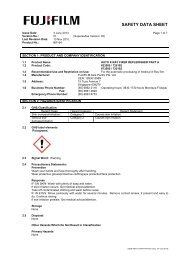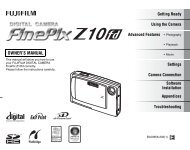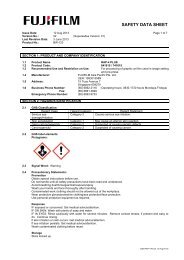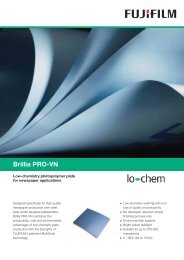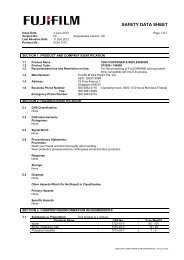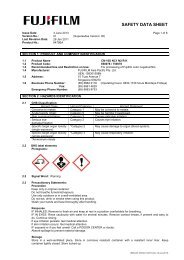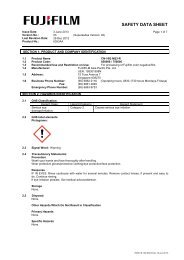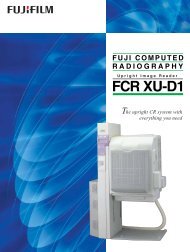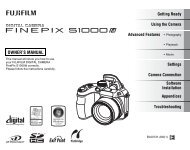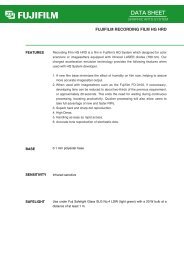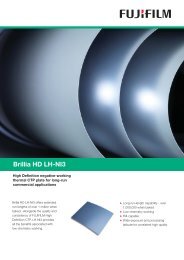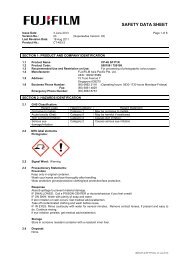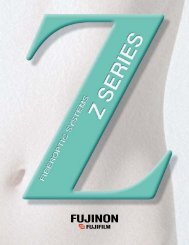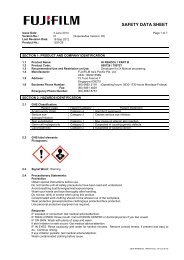Data Sheet - Fujifilm
Data Sheet - Fujifilm
Data Sheet - Fujifilm
Create successful ePaper yourself
Turn your PDF publications into a flip-book with our unique Google optimized e-Paper software.
1. FEATURES AND USES<br />
FUJICOLOR SUPERIA 1600 [CU] is a daylight-type ISO<br />
1600 color negative film that incorporates 4th Color<br />
Layer and the newly developed Nano-structured Σ<br />
(Sigma) Grain Technology to achieve high image quality<br />
when printed on FUJICOLOR papers.<br />
• Excellent Grain<br />
Quality<br />
• Ultrahigh Speed<br />
• Wide Exposure<br />
Latitude<br />
• Vibrant,<br />
Natural Color<br />
Reproduction<br />
• Excellent<br />
Sharpness<br />
Features Results<br />
• Excellent Exposure<br />
Suitability even<br />
under Fluorescent<br />
Lighting<br />
• Excellent Gray<br />
Balance<br />
• Highly uniform fine grain,<br />
regardless of the film’s<br />
ultrahigh speed<br />
• High suitability for low-light<br />
environments, such as<br />
indoor home scenes,<br />
wedding ceremonies,<br />
parties, stage performances,<br />
sunset and night<br />
scenes, as well as fast<br />
action, sports scenes,<br />
night-sky photography,<br />
and press photography<br />
• Remarkable results in<br />
bright surroundings such<br />
as in outdoor photography<br />
under clear skies, providing<br />
good image depth and<br />
high fidelity even if underexposed<br />
• Vibrant and dynamic reds,<br />
blues, and yellows<br />
• Violets and a variety of<br />
greens with enhanced<br />
fidelity<br />
• Extremely sharp depiction<br />
of all aspects of the<br />
subject, from overall form<br />
to textural details<br />
• Accurate color reproduction<br />
even under fluorescent<br />
lights<br />
• Precisely maintained gray<br />
balance throughout, from<br />
the brightest highlights to<br />
the deepest shadows<br />
It requires no color-compensating filters when used<br />
under daylight conditions or with an electronic flash.<br />
– 1 –<br />
2. SPEED<br />
AF3-145E<br />
COLOR NEGATIVE FILMS<br />
[CU]<br />
Light Source Speed Filter<br />
Daylight ISO 1600/33° None<br />
Tungsten Lamps<br />
(3200K)<br />
ISO 400/27°*<br />
LBB-12**<br />
(or Wratten No.80A)<br />
* Indicates the effective speed resulting from designated filter use.<br />
** Fuji Light Balancing Filter<br />
3. EXPOSURE GUIDE<br />
Use an exposure meter for exposure determination. If a<br />
meter is not available, refer to the following table.<br />
Daylight Exposure Guide Table<br />
Light<br />
Conditions<br />
Lens<br />
Aperture<br />
Shutter<br />
Speed (sec.)<br />
Seashore<br />
or Snow<br />
Scenes<br />
under<br />
Bright<br />
Sun<br />
f/22<br />
Bright<br />
Sunlight<br />
f/16<br />
Hazy<br />
Sunlight<br />
f/16<br />
Cloudy<br />
Bright<br />
f/11<br />
1/2000 1/1000<br />
Cloudy<br />
Day or<br />
Open<br />
Shade<br />
NOTES • The foregoing settings are for 2 hours after sunrise<br />
and 2 hours before sunset.<br />
• Provide lens openings 1/2-stop smaller during the<br />
summer and 1/2-stop larger during the winter.<br />
• Excessively bright (or dark) or backlighted subjects<br />
may require plus or minus 1-stop lens opening adjustments.<br />
Low Light Exposure Guide Table<br />
Light<br />
Conditions<br />
Lens<br />
Aperture<br />
Shutter<br />
Speed (sec.)<br />
Fine<br />
Weather<br />
Daytime<br />
Indoor<br />
Scenes<br />
f/2.8 to 5.6<br />
1/250<br />
Nighttime<br />
Indoor<br />
Scenes<br />
(under<br />
Fluorescent<br />
Light)<br />
f/2.8 to 4<br />
1/60<br />
Evening<br />
Scenes<br />
f/4 to 5.6<br />
1/125<br />
f/8<br />
Night<br />
Scenes<br />
f/2.8 to 4<br />
1/60<br />
NOTE Since light intensities for indoor and night scenes vary<br />
widely from location to location, the data above should<br />
be used only as a guide.
FUJIFILM PRODUCT INFORMATION BULLETIN • FUJICOLOR SUPERIA 1600 [CU]<br />
4. EXPOSURE UNDER VARIOUS LIGHT<br />
CONDITIONS<br />
Daylight<br />
Even when exposed under morning or evening twilight<br />
conditions or when color temperatures are low, no special<br />
filter use is needed as color balancing can be done<br />
during printing.<br />
Electronic Flash<br />
• Electronic flash produces light similar to daylight, so<br />
filters are not needed. However, the possibility of undesirable<br />
effects on color balance, due to various<br />
factors (differences in equipment, amount of use,<br />
etc.) should be taken into consideration. Test exposures<br />
are recommended.<br />
• If shutter speeds slower than 1/125 second are used,<br />
light from non-flash sources, such as room lighting,<br />
may cause color imbalances. Make test exposures.<br />
• The use of a flash meter is advisable, but the following<br />
formula can also be used to obtain satisfactory<br />
lens opening.<br />
Lens<br />
Aperture Electronic Flash Guide Number (at ISO 1600)<br />
=<br />
(f-number) Electronic Flash-to-Subject Distance (meters or feet)<br />
• Set the film speed at ISO 1600. Since the amount of<br />
light reflected onto subjects from surrounding surfaces<br />
will differ with the conditions, refer to the flash<br />
unit instructions.<br />
Daylight Photoflood/Photo-Reflector Lamps<br />
• Daylight-type photoflood or photo-reflector lamp output<br />
may be lower than that indicated by an exposure<br />
meter, so it is advisable to compensate for this by increasing<br />
exposure time or the lens opening. Whenever<br />
possible, test exposures are recommended.<br />
• Other factors requiring consideration when determining<br />
the exposure time, are lamp configuration, use<br />
duration and line voltage, as they may affect lamp<br />
output and color balance.<br />
Fluorescent Lamps & High-Intensity Discharge<br />
Lamps<br />
• For the best results, the following combinations of<br />
color compensating filters are recommended. However,<br />
for exacting work, test exposures are advisable.<br />
– 2 –<br />
Lamp Type<br />
Color<br />
Compensating<br />
Filters*<br />
Exposure<br />
Corrections**<br />
Daylight<br />
(D)<br />
10M<br />
+10Y<br />
+1/3<br />
Fluorescent<br />
Cool<br />
White<br />
(C.W)<br />
—<br />
—<br />
White<br />
(W)<br />
10C<br />
+1/3<br />
Warm<br />
White<br />
(W.W)<br />
30C<br />
+30M<br />
+1<br />
High-Intensity<br />
Discharge<br />
Deluxe<br />
Clear<br />
White<br />
Mercury<br />
Mercury<br />
10C<br />
+1/3<br />
40M<br />
+40Y<br />
+1 1/3<br />
* Fuji Color Compensating Filters (or Wratten Color Compensating<br />
Filters)<br />
** Exposure correction values include filter exposure factors.<br />
These values are added to unfiltered exposure meter readings.<br />
A “+” followed by a number indicates the required increase<br />
in lens opening.<br />
• When the fluorescent lamp characteristics are unknown,<br />
to obtain generally acceptable results, use a<br />
30M compensating filter and open the lens one stop<br />
(+1).<br />
NOTE Different compensation may be required according to<br />
special lamp types and length of use, so test exposures<br />
are recommended, whenever possible.<br />
• Shutter speeds of 1/125 second for high-intensity<br />
discharge lamps and 1/30 second or larger, for fluorescent<br />
lamps, will avoid AC power-induced changes<br />
in brightness and color being recorded on the film.<br />
Tungsten Lamps<br />
A Fuji Light Balancing Filter LBB-12 (or Wratten filter<br />
No.80A) is recommended along with a 2-stop increase<br />
in lens opening, when using 3200 K tungsten lighting. In<br />
the case of cameras with TTL metering, there is no need<br />
for additional exposure compensation.<br />
5. LIGHTING EQUIPMENT<br />
The condition of umbrellas, reflectors, diffusers and like<br />
devices, could influence photographic light quality. Periodically<br />
check lighting equipment for deterioration.<br />
6. LONG EXPOSURE COMPENSATION<br />
No exposure or color balance compensation is required<br />
for exposures within a 1/4000 to 2 second shutter speed<br />
range. However, for exposures of 4 seconds or longer,<br />
provide the compensations indicated below.<br />
Exposure Time (sec.) 1/4000 to 2 4 16 64<br />
Exposure Corrections* Unnecessary + 2/3 + 11/2 + 2<br />
* A “+” followed by a number indicates the required increase in<br />
lens opening.<br />
Except for special effects, the normal intensity ratio for<br />
main-to-fill subject lighting should remain within 1:4 limits.
7. FILM HANDLING<br />
• Expose film before the expiration date indicated on<br />
the film package and process as soon as possible<br />
after exposure.<br />
• When loading and unloading roll film, avoid direct<br />
sunlight. If there is no shade, turning one’s back toward<br />
the sun will shade the film.<br />
• Camera-loaded film should be exposed and processed<br />
immediately.<br />
• Unprocessed film should be kept away from X-rays<br />
used to inspect checked-in baggage, etc. at airport<br />
terminals. Strong X-rays can cause fogging of unprocessed<br />
film. It is recommended such film be<br />
placed in your carry-on baggage whenever possible.<br />
(Consult with airport personnel for details.)<br />
• Film fogging may occur near X-ray equipment used<br />
in hospitals, factories, laboratories and other locations.<br />
Always keep film away from possible sources<br />
of radiation.<br />
9. SPECIFICATIONS AND PACKAGING<br />
9-1 Specifications<br />
• Code<br />
• Speed<br />
• Type<br />
• Process<br />
• Size<br />
Item<br />
• Production Number<br />
CU<br />
ISO 1600/33°<br />
Daylight<br />
CN-16, CN-16Q, CN-16FA,<br />
CN-16L, CN-16S or C-41<br />
135: 12-, 24- and 36-exp.<br />
P51 and above<br />
FUJICOLOR SUPERIA 1600 [CU] • FUJIFILM PRODUCT INFORMATION BULLETIN<br />
– 3 –<br />
8. FILM STORAGE<br />
Unprocessed Film<br />
• Storing exposed or unexposed film under hot and<br />
humid conditions may adversely affect speed, color<br />
balance and physical property changes. Store film<br />
under the following conditions.<br />
⎧<br />
⎨<br />
⎩<br />
Ï Ordinary Storage: Protect from heat.<br />
Ï Long-term Storage: Below 0°C (32°F)<br />
• Building materials, finishes used on newly manufactured<br />
furniture, paints and bonding agents may produce<br />
gases which affect photographic film. Do not<br />
store film, lightproof boxes of film, loaded cameras or<br />
film holders near these materials.<br />
• Before use, allow films to stand at room-temperature<br />
over 1 hour. Opening the package/box while film is<br />
cold may cause harmful condensation.<br />
Processed Film<br />
Exposure to light, high temperature and humid conditions<br />
can cause color changes in processed films.<br />
Therefore, place such films in sleeves and store them in<br />
dark, dry, cool and well ventilated locations under the<br />
following conditions.<br />
⎧<br />
⎪<br />
⎨<br />
⎪<br />
⎩<br />
Ï General Storage:<br />
Below 25°C (77°F) at 30% to 60% RH<br />
Ï Long-term Storage:<br />
Below 10°C (50°F) at 30% to 50% RH<br />
NOTE As with all color dyes, those used in this film will discolor<br />
or fade with time.<br />
9-2 Edge Markings<br />
Item<br />
• Edge Stripe<br />
• Type Designation<br />
• Generation Number<br />
• Latent Image Bar Code<br />
• FUJIFILM Identification<br />
Code<br />
Negative Carrier<br />
: 135B<br />
: 135C/D/J/K/S<br />
One red solid line and one<br />
green short broken line on one<br />
side (changed)<br />
S-1600<br />
CU-4<br />
39-8<br />
0172<br />
370
FUJIFILM PRODUCT INFORMATION BULLETIN • FUJICOLOR SUPERIA 1600 [CU]<br />
SUPERIA 1600<br />
Production<br />
Number<br />
9-3 Packaging<br />
Item<br />
• Box Design<br />
(unchanged)<br />
Production<br />
Identification Code<br />
Latent Image Bar Code<br />
Identification Color: Black<br />
• Cartridge Design<br />
(unchanged)<br />
Identification Color: Black<br />
10. TECHNOLOGIES INCORPORATED<br />
IN SUPERIA 1600<br />
Generation Number<br />
10-1 Nano-structured Σ (Sigma) Grain<br />
Technology<br />
• The new SUPERIA 1600 has incorporated the newly<br />
developed Nano-structured Σ (Sigma) grain, a further<br />
advance over the current emulsion technology, to<br />
achieve sharp, smooth image quality, regardless of<br />
the film’s ultrahigh speed.<br />
• To achieve the high sensitivity and small volume of<br />
the Nano-structured Σ (Sigma) grain, uniform, thincrystal<br />
technology was used to produce crystals that<br />
are approximately 60% thinner than the hexagonal<br />
crystals used in the current SUPERIA 1600 film. The<br />
higher uniformity in size and improved light-collection<br />
efficiency of these grains have made possible a film<br />
with higher sensitivity than that of the current<br />
SUPERIA 1600 and smooth grain quality, regardless<br />
of the film’s ultrahigh speed.<br />
10-2 Super Efficient Coupler Technology<br />
The use of new couplers has enhanced color development<br />
efficiency.<br />
Edge Stripe<br />
(green and red)<br />
– 4 –<br />
9-4 Post-Processing Masking Colors<br />
Same as those for the current SUPERIA 1600.<br />
11. PROCESSING<br />
This film is intended for processing by <strong>Fujifilm</strong> Processes<br />
CN-16, CN-16Q, CN-16FA, CN-16L, CN-16S or<br />
Process C-41.<br />
11-1 Replenishment Rate<br />
The following table shows the replenishment rates for<br />
each type of <strong>Fujifilm</strong> Processes.<br />
Processing<br />
Solution<br />
NQ1-R<br />
NQ2-R<br />
NQ3-R<br />
NQS<br />
NQ4-R<br />
Processing<br />
Solution<br />
N1-R<br />
N2-R<br />
N3-R<br />
NS<br />
N4-R<br />
CN-16Q<br />
CN-16L<br />
Type Designation<br />
Replenishment<br />
Rate*<br />
41<br />
20<br />
30<br />
30<br />
20<br />
Replenishment<br />
Rate*<br />
19<br />
5<br />
8<br />
17<br />
15<br />
Processing<br />
Solution<br />
N1-R<br />
N2-R<br />
N3-R<br />
NS<br />
N4-R<br />
Processing<br />
Solution<br />
N1-R<br />
N2-R<br />
N3-R<br />
N4-R<br />
Production<br />
Identification Code<br />
CN-16FA<br />
CN-16S<br />
Replenishment<br />
Rate*<br />
21<br />
5<br />
16<br />
34<br />
20<br />
Replenishment<br />
Rate*<br />
14.3<br />
5<br />
7.5<br />
30<br />
*Replenishment Rate ...... Replenisher volume (mL) per single roll<br />
(135/24 exp.)
4-2 Processing Solution Control<br />
Use the current 135-size control strips for processing<br />
solution control.<br />
4-3 Processing-Photographic Characteristics<br />
Same as those for the current SUPERIA 1600.<br />
12. PRINTER CONDITIONS<br />
This film can be printed on the same printer setup with<br />
results similar to the current film. However, depending<br />
on the printer type, a slight blue cast might appear in the<br />
overexposed areas. If this occurs, adjustment of printer<br />
conditions may be necessary.<br />
14. FILM STRUCTURE<br />
15. DIFFUSE RMS GRANULARITY VALUE .............. 7<br />
Micro-densitometer Measurement Aperture: 48 µm in diameter<br />
Magnification: 12 ×<br />
Sample Density: 1.0 above minimum density<br />
16. RESOLVING POWER<br />
Chart Contrast 1.6 : 1 .......................... 50 lines/mm<br />
Chart Contrast 1000 : 1 ........................ 125 lines/mm<br />
FUJICOLOR SUPERIA 1600 [CU] • FUJIFILM PRODUCT INFORMATION BULLETIN<br />
– 5 –<br />
13. JUDGING EXPOSURE RESULTS<br />
SUPERIA 1600 exposure results can be accurately predicted<br />
by using an electronic densitometer equipped<br />
with Status M filters. An 18% gray card, receiving the<br />
same illumination as the subject, when read through the<br />
RED filter should render density readings between 0.65<br />
and 0.85 (for exposures under recommended lighting<br />
and with optimal film processing).
FUJIFILM PRODUCT INFORMATION BULLETIN • FUJICOLOR SUPERIA 1600 [CU]<br />
Density<br />
Response (%)<br />
17. CHARACTERISTIC CURVES 18. SPECTRAL SENSITIVITY CURVES<br />
4.0<br />
3.5<br />
3.0<br />
2.5<br />
2.0<br />
1.5<br />
1.0<br />
0.5<br />
0.0<br />
–4.0 –3.0 –2.0 –1.0 0.0<br />
Exposure [log H (lux-seconds)]<br />
19. MTF CURVE 20. SPECTRAL DYE DENSITY CURVES<br />
150<br />
100<br />
70<br />
50<br />
30<br />
20<br />
10<br />
7<br />
5<br />
Exposure : Daylight, 1/125 sec.<br />
Process : CN-16<br />
Densitometry : Status M<br />
Exposure : Daylight<br />
Process : CN-16X<br />
Blue<br />
Green<br />
Red<br />
3<br />
2<br />
1 5 10 20 50 100 200<br />
Spatial Frequency (cycles/mm)<br />
NOTICE The data herein published were derived from materials taken from<br />
general production runs. However, as <strong>Fujifilm</strong> is constantly upgrading the quality<br />
of its products, changes in specifications may occur without prior notice.<br />
– 6 –<br />
Relative Sensitivity* (log)<br />
1.0<br />
Spectral Diffuse Density<br />
2.0<br />
1.0<br />
0.0<br />
FUJI PHOTO FILM CO., LTD.<br />
26-30, Nishiazabu 2-chome, Minato-ku, Tokyo 106-8620, Japan<br />
Blue<br />
Sensitive<br />
Layer<br />
Process : CN-16<br />
Densitometry : Status M<br />
Density : 1.0 above D-min.<br />
Green<br />
Sensitive<br />
Layer<br />
Cyan<br />
Sesitive<br />
Layer<br />
Red<br />
Sensitive<br />
Layer<br />
400 500 600 700<br />
Wavelength (nm)<br />
* Sensitivity equals the reciprocal of the exposure<br />
(J/cm²) required to produce a specified density.<br />
Typical densities for a mid-scale<br />
neutral subject and for D-mini.<br />
Mid-scale Density<br />
Minimum Density<br />
400 500 600 700<br />
Wavelength (nm)<br />
Ref. No. AF3-145E (EIGI-03.2-HB•5-1) Printed in Japan



